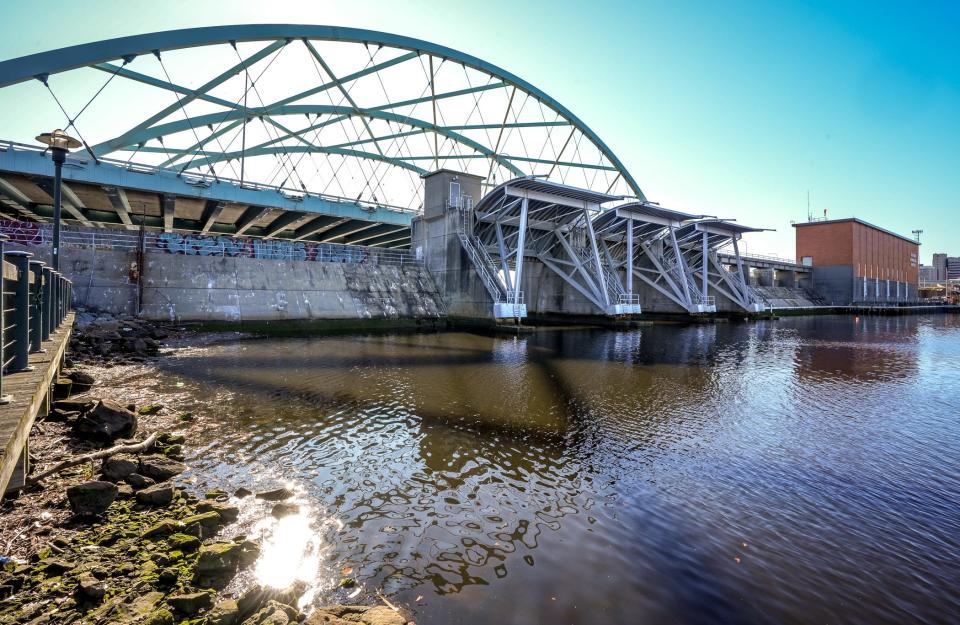Providence's hurricane barrier is ready for Hurricane Lee. Here's how it will work.
PROVIDENCE – If Hurricane Lee starts heading towards Rhode Island, the crew at the Fox Point Hurricane Barrier is prepared.
Staff with the U.S. Army Corps of Engineers will be on-site tracking the path of the storm well ahead of a wind-driven surge or an unusually high tide that could warrant closing the barrier that protects downtown Providence from flooding.
“USACE is closely monitoring the forecast and will be prepared to operate the barrier if conditions warrant a closure,” said John MacPherson, Cape Cod Canal manager for the Corps who is also responsible for the Fox Point barrier.
As the storm continues to move west, the National Weather Service warned on Thursday of "dangerous surf and rip current conditions affecting much of the East Coast of the United States." Tropical storm conditions were also reported on Bermuda.

Has the hurricane barrier closed recently?
If the Army Corps closes the hurricane barrier, it will be the first time this year. The barrier was closed three times last year.
The structure was built as a hurricane defense, but in recent years it’s also been used to seal off the 280 acres behind its gates during king or moon tides when waters in the Providence River are projected to be much higher than normal. As seas have risen, those tides are reaching higher and have been known to flood the area around Waterplace Park.
When was the hurricane barrier built, and when was it used?
The decision to build the barrier was made in the wake of Hurricane Carol in 1954, which sent a wall of water through Providence. It was the second time in 16 years that a storm surge flooded the city, following the Hurricane of 1938.
Since its dedication in 1966, the barrier has been called on to protect the city from a storm surge only a few times. The most notable in recent years was during Superstorm Sandy in 2012 when the surge in Narragansett Bay reached 7.6 feet above mean sea level.
The structure was designed to handle surges more than two-and-a-half times as high, including a repeat of the ‘38 hurricane.
More on RI storms: Is Hurricane Lee coming for Rhode Island? A look back at hurricane damage from years past
How does the Providence hurricane barrier work?
The barrier consists of a 25-foot-high central dam that stretches 700 feet across the Providence River with three gates that can be lowered when flooding is predicted. Flanking each side of the barrier are retaining walls and dikes that extend 780 feet to the east, toward India Point Park, and 1,400 feet to the west, along Allens Avenue. In five places where roads cut through them are gates that can be closed. Underground, there are another five gates to prevent water from backing up in the sewer system.
When the gates are closed, powerful pumps send water to the Bay side of the barrier to prevent the river on the city side from overflowing its banks.
More: With seas rising, study will ask — is Providence's hurricane barrier up to the task?
After Hurricane Katrina in 2005, the Army Corps took over operation of the barrier itself, while the wing walls on either side remained the responsibility of the city. Since then, the Corps has spent millions to refurbish the structure. The city has also replaced parts of the walls and this summer embarked on a new set of repairs.
But there are still bigger concerns about the structure and whether its design can withstand the impacts of rising seas and changing storm patterns. Earlier this year, the Corps was allocated $1 million to study the future of the barrier. It’s expected to be completed next year.
“The study just started, and the group is currently finalizing the scope of work,” said MacPherson.
Contributing: Cybele Mayes-Osterman, USA TODAY
This article originally appeared on The Providence Journal: How Rhode Island hurricane barrier could help limit Hurricane Lee damage

